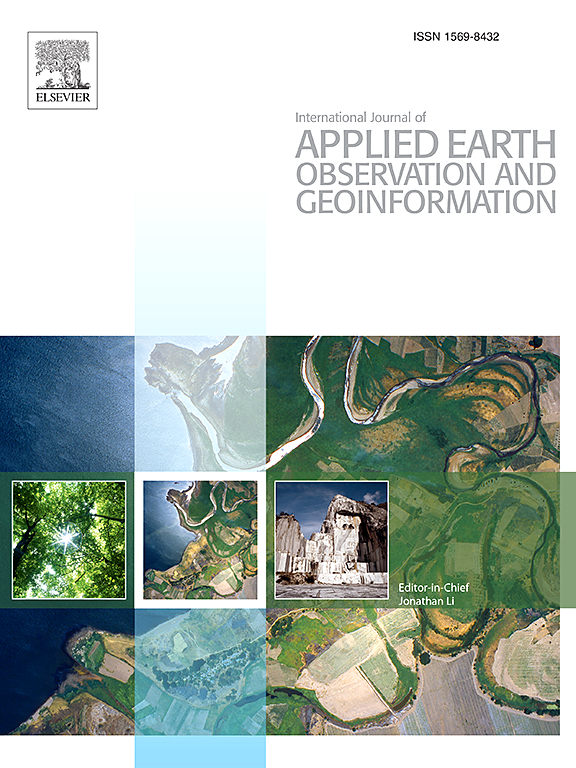基于无人机多光谱数据的草本植物冠层平均性状预测:寻求更好的叶片-冠层升级方法
IF 8.6
Q1 REMOTE SENSING
International journal of applied earth observation and geoinformation : ITC journal
Pub Date : 2025-06-06
DOI:10.1016/j.jag.2025.104650
引用次数: 0
摘要
成像光谱技术已成为估算植物冠层尺度性状的关键技术。准确的性状预测对生物多样性保护至关重要,但对物种混合复杂的异质湿地冠层性状的研究仍然很少。虽然群落加权平均(CWM)方法已被广泛用于将叶片性状上尺度提升到冠层水平,但其模型精度往往较低,并且利用成像光谱预测冠层平均性状的替代上尺度方法的适用性仍不确定。本文提出了一种利用几何平均方法计算冠层平均性状的新方法,并将其与结合偏最小二乘回归(PLSR)、随机森林回归(RF)和支持向量机回归(SVM)三种建模算法的CWM方法的性能进行了比较。利用高空间分辨率无人机多光谱数据对9个冠层平均性状的预测能力进行了评价。分析的重点是具有高度物种多样性和水文变异性的湿地生态系统,其中精确的植物性状估算对生态过程建模至关重要。结果表明,几何平均方法与支持向量机模型(如N = 0.64, SLA = 0.38,纤维素= 0.33)配对时,对大多数冠层平均性状的验证精度最高。值得注意的是,几何平均方法结合无人机多光谱数据,显著提高了对N的预测性能,甚至超过了高光谱数据。该研究强调了几何平均方法在将叶片性状升级为冠层性状方面的潜力。这些发现有助于提高植物功能性状的遥感预测精度,而未来的研究可能会探索深度学习方法的整合。本文章由计算机程序翻译,如有差异,请以英文原文为准。
Prediction of canopy mean traits in herbaceous plants by the UAV multispectral data: The quest for a better leaf-to-canopy upscaling method
Imaging spectroscopy has become a pivotal technique for estimating plant traits at the canopy scale. Accurate trait prediction is critical for biodiversity conservation, yet research on canopy traits in heterogeneous wetlands with complex species mixtures remains scarce. While the Community-Weighted Mean (CWM) method has been widely used for upscaling leaf traits to the canopy level, it often suffers from low model precision, and the suitability of alternative upscaling methods for predicting canopy mean traits using imaging spectroscopy remains uncertain. This study proposed a novel approach for calculating canopy mean traits using the geometric mean method and compared its performance to that of the CWM methods in combination with three modeling algorithms Partial Least Squares Regression (PLSR), Random Forest regression (RF), and Support Vector Machine regression (SVM). The accuracy was evaluated by exploring the predictive ability for nine canopy mean traits by using high spatial resolution UAV multispectral data. The analysis focuses on a wetland ecosystem characterized by high species diversity and hydrological variability, where precise plant trait estimation is essential for ecological process modeling. The results demonstrated that the geometric mean method yielded the highest validation accuracy for most canopy mean traits when paired with the SVM model (e.g., R2 for N = 0.64, SLA = 0.38, and cellulose = 0.33). Notably, the geometric mean method, combined with UAV multispectral data, significantly enhanced the predictive performance for N, surpassing even that of hyperspectral data. This study underscores the potential of the geometric mean method for upscaling leaf traits to canopy traits. These findings contribute to advancing the prediction accuracy of plant functional traits through remote sensing techniques, while future studies may explore the integration of deep learning methods.
求助全文
通过发布文献求助,成功后即可免费获取论文全文。
去求助
来源期刊

International journal of applied earth observation and geoinformation : ITC journal
Global and Planetary Change, Management, Monitoring, Policy and Law, Earth-Surface Processes, Computers in Earth Sciences
CiteScore
12.00
自引率
0.00%
发文量
0
审稿时长
77 days
期刊介绍:
The International Journal of Applied Earth Observation and Geoinformation publishes original papers that utilize earth observation data for natural resource and environmental inventory and management. These data primarily originate from remote sensing platforms, including satellites and aircraft, supplemented by surface and subsurface measurements. Addressing natural resources such as forests, agricultural land, soils, and water, as well as environmental concerns like biodiversity, land degradation, and hazards, the journal explores conceptual and data-driven approaches. It covers geoinformation themes like capturing, databasing, visualization, interpretation, data quality, and spatial uncertainty.
 求助内容:
求助内容: 应助结果提醒方式:
应助结果提醒方式:


